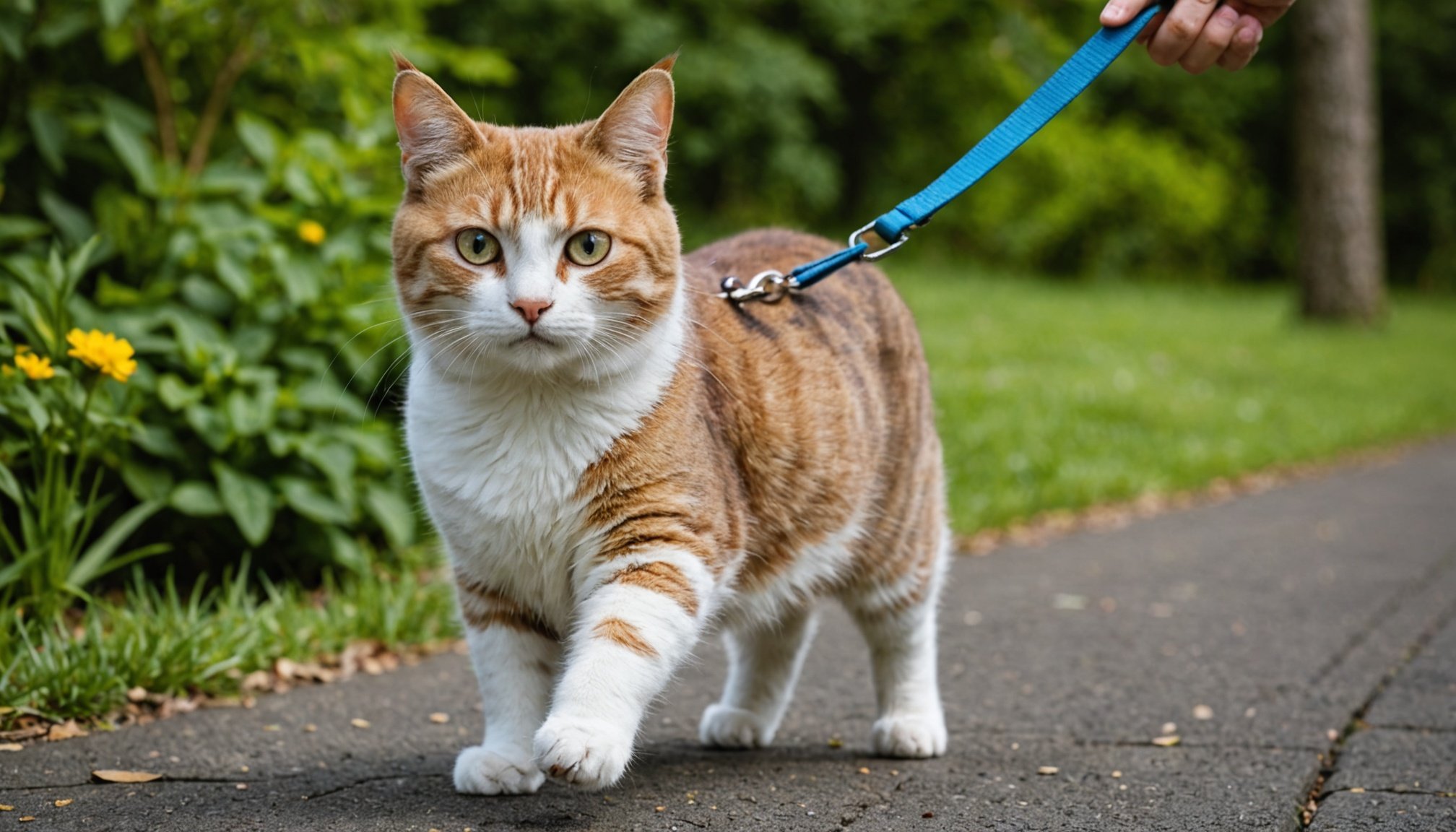Understanding Leash Training for Cats
Leash training cats brings both safety and enrichment, aligning their natural exploratory nature with secure outdoor enjoyment. While some may view a cat leash as an unusual concept, the benefits of leash training are plentiful. Cats are inherently curious, and allowing them controlled outdoor access satisfies their instinctual desire to explore, while keeping them protected from dangers such as traffic or other animals.
Key Benefits of Leash Training
- Safety: Cats that are leash-trained can enjoy the outdoors without the risks typical of free-roaming, such as getting lost or injured.
- Stimulation: The variety of sights, sounds, and smells they experience can significantly enrich their lives.
- Exercise: Regular outdoor walks can help prevent obesity and promote better health in cats.
Understanding your cat’s natural behavior is crucial when introducing them to leash training. Cats are territorial and highly sensitive to new environments. Gradually acclimating them to the outdoors will alleviate stress and increase confidence. Patience is essential, as each cat responds differently to leash training. Recognizing and respecting these behaviors during outdoor ventures ensures a more rewarding experience for both you and your feline companion. By comprehending and prioritizing these aspects, you enhance the bond with your cat, enriching their life and boosting their confidence safely.
This might interest you : Transform your cat”s behavior: proven techniques to encourage scratching posts instead of your furniture
Choosing the Right Harness and Leash
Selecting the best cat harness and the appropriate leash is crucial for successful leash training. Various types of cat harnesses exist, including vest, H-style, and figure-eight designs. Vest-style harnesses offer security and comfort, often preferred for their snug fit. In contrast, H-style and figure-eight harnesses are adjustable but may provide less coverage.
When considering a leash, it’s essential to weigh the types of cat leashes available. Retractable leashes offer freedom but might startle a timid cat with sudden reeling or snapping. Alternatively, a standard nylon or cotton leash offers reliable control without added frills.
Topic to read : Proven strategies for caring for your arthritis-affected cat: essential insights for feline wellbeing
A proper fit is pivotal for the comfort and safety of your feline. To fit a harness correctly, ensure it sits snugly without restricting movement or breathing. You should fit two fingers comfortably between the harness and your cat’s body, confirming it’s neither too tight nor too loose. Regular checks and adjustments accommodate shifting fur and weight changes, maintaining a secure fit.
Taking these factors into account not only enhances your cat’s security but ensures your outdoor excursions are as enjoyable as possible. Investing time in selecting the right equipment reflects your understanding of their comfort and builds their confidence.
Common Challenges and Solutions
Leash training cats can present various challenges, often tied to their natural caution and independent spirit. One of the most frequent issues is reluctance or fear of the harness. Cats may resist wearing it due to unfamiliarity or discomfort. To overcome this, start by letting your cat explore the harness at their own pace, associating it with positive experiences, like treats.
Another common obstacle is outdoor fear. Cats might be overwhelmed by the sounds, sights, and smells. Introducing them to the outdoors gradually can help. Begin with short, quiet sessions before attempting longer walks in busier areas.
Cat behavior issues, such as pulling or sitting stubbornly, need attention too. Patience and consistent reinforcement of positive behavior are key. Using treats and verbal praise encourages good habits. Consider adjustments in training based on your cat’s unique reactions and preferences.
For persistent challenges, seeking help from cat behaviorists can provide tailored strategies. Their expertise in overcoming training setbacks can be invaluable. By understanding your cat’s personality and adjusting your approach, you can smooth the leash training journey, making it a positive experience for both you and your feline friend.
Step-by-Step Guide to Leash Training
Embarking on leash training requires a structured approach to build your cat’s confidence. Here’s a step-by-step training guide to help you get started.
Begin by introducing the harness indoors, allowing your cat to explore it without pressure. Let them sniff or play around it, rewarding with treats to form positive associations. Once comfortable, gently put the harness on your cat for short intervals, gradually increasing the duration as their ease grows.
Next, incorporate leash training techniques by attaching a small, lightweight leash while indoors. Practice guiding them on a leash, using gentle coaxing with treats or toys. Reinforce positive behavior consistently with praise when they respond well to guidance.
Transitioning to the outdoor environment requires building confidence in cats slowly. Start with leash training in a safe, enclosed area before moving to open outdoor spaces. Be patient, especially if your cat appears hesitant.
Throughout the process, observe how your cat reacts and adjust the method based on their comfort level. Always respect your cat’s limits to ensure they feel secure during each training session. Incorporating these steps helps foster a positive leash training experience.
Safety Considerations During Outdoor Adventures
When engaging in outdoor cat safety activities like leash training, understanding potential risks is crucial. Recognise leash training hazards to ensure your feline’s security. Navigating spaces with traffic, other animals, and unfamiliar terrain requires vigilance. Invest in a sturdy, well-fitted harness and avoid retractable leashes that might startle or harm the cat.
Before heading out, consider developing a checklist to guarantee preparedness. Items such as a collapsible water bowl, treats, and a cat-friendly backpack can enhance the experience, making sure you’re always ready during these adventures.
Preparing for outdoor activities involves inspecting the area for safety hazards like toxic plants or sharp objects. Training your cat to respond to commands helps manage unexpected situations. Observing your cat’s reactions to different stimuli can guide you in minimizing any emerging risks.
Exploring outdoor spaces with your cat shouldn’t compromise their well-being. Prioritising their comfort and safety ensures they derive pleasure from these experiences. Tailoring each outing to accommodate your cat’s temperament and energy levels supports a balance between exploration and security, enriching leash training outcomes.
Personal Anecdotes and Case Studies
When it comes to leash training success stories, owners have shared fascinating experiences, showcasing diverse cat training experiences. Many have found that patience and consistency play vital roles. One owner recounted a slow, steady process involving treats and gentle encouragement that turned a wary feline into a confident outdoor explorer. These stories underline the value of understanding each cat’s temperament and adapting the approach accordingly.
Shared cat training tips often highlight the importance of observation and patience. For instance, one useful tip from experienced owners is letting the cat lead initially, fostering a sense of control and reducing anxiety. Another common piece of advice is the use of a quiet, safe environment for the first outdoor adventures, avoiding busy or noisy areas which might overwhelm the cat.
Enthusiastic owners also shared that the leash training benefits are plentiful. The increased outdoor exercise and stimulation have led to noticeable improvements in their cats’ health and happiness. By learning from these personal experiences, new cat owners can approach leash training informed and encouraged, ready to explore the outdoors with their feline friends.
Expert Advice on Leash Training
Consulting cat training experts can significantly enhance the benefits of leash training. Experts bring insights that can transform a challenging process into a fruitful one. One common question: How can professional advice impact training outcomes? The answer lies in their ability to tailor strategies to a cat’s unique personality, offering solutions aligned with the cat’s natural instincts and behavior patterns.
Trainers often recommend short, rewarding sessions to build trust. This advice is pivotal, particularly for skittish cats. Additionally, professional guidance assists in choosing the best cat harness and understanding proper usage techniques, ensuring comfort and security.
When selecting professional help, consider the trainer’s experience with various cat breeds and behaviors. Why is it essential to continue education in cat behavior and training techniques? Simply put, ongoing education helps address changes in your cat’s behavior effectively, keeping the training both productive and enjoyable.
Professional consultations can dramatically ease the process, helping cat owners tackle cat behavior issues and refine their leash training approach. By aligning professional insights with a cat’s needs, owners strengthen their bond with their feline companions, enriching the overall experience.











